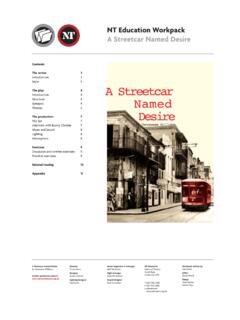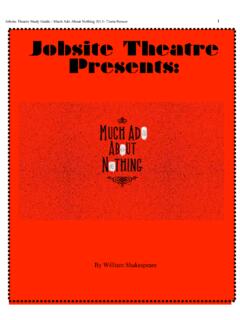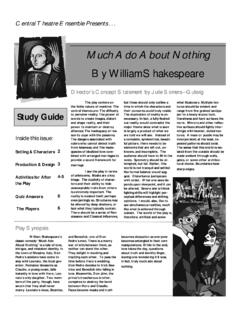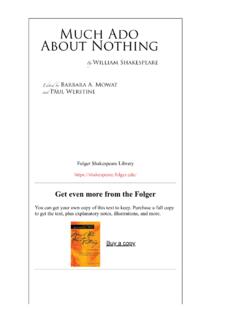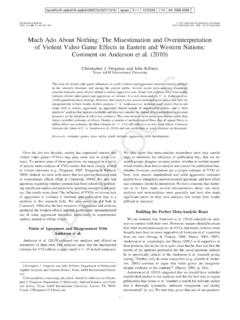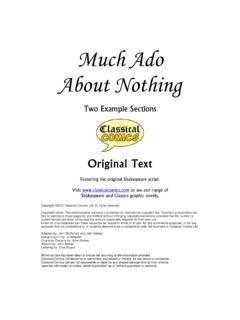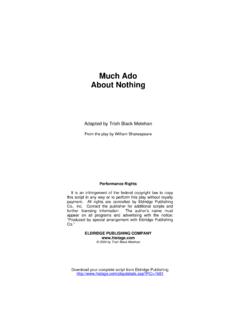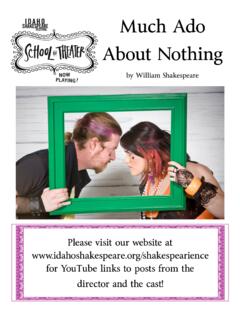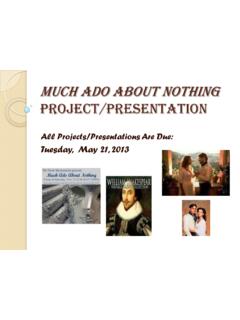Transcription of Much Ado About Nothing by William Shakespeare MuchAdo ...
1 National Theatre Education WorkpackMuch Ado About Nothingby William ShakespeareKey Stage Three WorkpackThe National s production ContentsIntroduction 2 For teachers: classroom exercisesNarrative 3 Character (status) 9 Character work 11 Imagery 16 Imagery/language 17 Themes 18 Language 22 Teaching notes 25-30(Part 2)For students: Worksheets 32-55 Further production details: workpack is published by and copyright The Royal National Theatre BoardReg. No. 1247285 Registered Charity No. 224223 Views expressed in this workpack are not necessarily those of the National TheatreDirectorNicholas HytnerNT Education National TheatreSouth Bank London SE1 9 PXT 020 7452 3388F 020 7452 3380E educationenquiries@ writerKate BealesEditorEmma GosdenDesign Patrick EleyClare ParkerEducationMuch AdoAboutNothingSponsored by ShellNational Theatre Education WorkpackIntroductionThis workpack has been designed for schools taking part in the NT Education KS3 workshop programme (although it may prove useful for anyone studying the text).
2 It comprises a series of specially devised games and exercises intended to work alongside the workshops, providing extra drama-based activities for students taking part in the programme. These exercises develop the theatrical techniques used in the workshops, which originate mainly in the rehearsal room as tools for workpack should be used as a pick and mix style tool kit it is not a scheme of work, and does not aim to reproduce material that is readily available online. There may be some exercises which you wish to use repeatedly, and others which you do not wish to use at all the pack is here for you to browse through, and to dip into as you see fit. Some exercises require movement and a clear space, and others can be done quite easily in the you are taking part in the KS3 programme, you may wish to discuss the material with your workshop leader, and to choose exercises which either follow up a particular workshop, or prepare for the next. The exercises are grouped under a series of headings, to enable you to focus on particular areas of work relevant to your class: Narrative Character Theme Language ImagerySome exercises have a related worksheet that the student can complete.
3 The worksheets appear as appendices at the end of the pack, and you can freely photocopy these in any size to distribute to your students. As Zo Wanamaker says, the joy of working (on a play in the theatre) is when you have time to explore it, dig into it and discover great things in it. The intention of this pack is to suggest some more ways of having fun with the story and with the text in order to discover the great things in it. We hope you and your class enjoy the experience of working on the play and seeing it in performance. 2 Rehearsal photo (Zo Wanamaker and Simon Russell Beale) by Catherine AshmoreNational Theatre Education WorkpackFast forward version [see worksheet 1] Ask the whole class to write a summary of the play in 10 succinct sentences Be very strict a sentence is not allowed to contain 10 sub clauses, but should consist of a single clear point Read a few out there may be significant differences between them Agree on what the 10 key points of the play should be and write a definitive 10- point summary Now ask the class to stand in a semi-circle Walk behind them, slowly reading the summary Each time you refer to a new character, tap the nearest person on the shoulder That person should run in to the centre and start acting out whatever their character is doing in the story at that moment They can add words if they wish Keep the action moving and see how much of the story is 7,3,1 [see worksheet 2]
4 Ask the class to write the story in 7 sentences, then 3, then 1 Read some out to the group, and discuss the similarities and 3 Trailer in 5 images [see worksheet 3] Divide the class into groups of 5 or 6. Explain that they are going to work on an ad-vertising trailer for a production of much Ado About Nothing First, they must agree on 5 key points in the story which they would like to show in their trailer Once these are agreed, the group should identify 5 keywords to accompany each point. These can be words from the text or may be thought up by the group Now the group should make a series of 5 freeze frames to illustrate their points, and find a way to link each freezeframe with movement The keywords should be spoken by the group at appropriate points throughout the sequence Once the group have rehearsed their sequences, ask them to add any other sound effects or movement if necessary Finally, ask the group to find a point in the sequnce to add the title and author of the play Have a dress rehearsal, and show each sequence to the rest of the To clarify the narrativeTo identify key themes and relationshipsTo create a comic synopsisAimS To distil the themes and ideas of the story.
5 So that everyone is clear what the play is aboutTo raise and discuss differences of opinion as to what the play is aboutAimS To be clear About the narrative journey of the playTo explore different key themes which students find within the narrativeTo express narrative and themes visuallyRehearsal photograph of members of the company by Catherine AshmoreNational Theatre Education WorkpackDetective games [see worksheet 4]There are several moments in the play where the characters refer to something that they have done, or plan to do, but the audience can only guess what has happened. There are no concrete answers to these questions, but an actor playing any one of these parts will want to make their own decisions, in order to help them create their characers. Ask your class to answer these questions any credible theories are acceptable Discuss them together how many different answers are there? What new questions do they raise?Questions the play raises and doesn t answer include: What happened between Beatrice and Benedick did he break her heart?
6 (he lent it me a while, and I gave him use for it 2,1,211ff) How does Borachio find a way to ensure that Hero is out of the way so that he can set up the trick with Margaret? (I will so fashion the matter that Hero shall be absent, 2, 2, 34-5) The circumstances surrounding the conflict between Don John and Don Pedro (you have of late stood out against your ) What happened to Beatrice s parents? (my mother ) Where is Antonio s son? (how now brother, where is your ) Why doesn t Beatrice know that Hero didn t sleep in her room the night before the wedding? (Until last night I have this twelve month been her ) And what About Margaret apparently not having any idea that her actions have led to Hero s accusation in the church? (she hath always been just and ) nb. in the film she gets it, but this isn t in the play! There may be Freezeframe Borachio s narrative a physical storyboard [see worksheet 5]After all the confusion with the Watch, Borachio tells Don Pedro very succinctly what exactly has happened (although he does put a bit of spin on his account, suggesting that it was all Don John s idea).
7 He says:Do you hear me and let this Count kill me. I have deceived even your very eyes. What your wisdoms could not discover, these shallow fools have brought to light, who in the night overheard me confessing to this man how Don John your brother incensed me to slander the Lady Hero, how you were brought into the orchard, and saw me court Margaret in Hero s garments, how you disgraced her when you should marry her. My villainy they have upon record, which I had rather seal with my death than repeat over to my shame. The lady is dead upon mine and my master s false accusation; and briefly, I desire Nothing but the reward of a villain. Divide the class into small groups of About five Read them Borachio s account a couple of times Ask each group to discuss what they have heard and pick out the sequence of events Borachio narrates They should turn this into a series of frozen images Now ask each group to present their images to the rest of the class, to see the entire story of Hero s death.
8 Variation 2-D Storyboarding You could also ask the class to storyboard this sequence as a series of images on paper4 AimS To develop the world of the playTo explore characters from new anglesTo encourage directorial decision makingNational Theatre Education WorkpackNarrative News coverage of wedding/trial [see worksheet 6] Ask the class to work as journalists or reporters covering the wedding of Hero and Claudio or the trial of Don John and Borachio They can write their articles either as broad-sheet or tabloid journalists, making the events as factual or sensational as they wish. Variation Ask students to write with a specific bias, for instance as a feminist reporter, a traditionalist, a supporter of Don John s party, Divide the class into groups, and give each group one mini-scene to work on (see overleaf) Ask the groups to sit down and read their scene, working out which part of the story they have, and what is going on After establishing what happens and who is in their scene, they should cast the actors In some cases there are actors present in a scene who do not have any lines Once the group have cast their scene, they should put their script in a safe place and make a frozen picture of the action of their part of the story When the groups are ready, show each frozen picture in order, asking the rest of the class to guess who is who and what is going on If any character is unclear, ask the class to help with suggestions of how to be clearer As you go round, tap individuals on the shoulder and ask them who they are and what they want in the scene.
9 This will help to ensure that everyone understands their role and why they are in the scene When all the groups have shown their pictures, ask them to make a silent movie of the events of their scene This should begin and end with a freeze, so that the audience knows when they are starting and finishing Show the silent movies, and encourage the audience to discuss what works best in telling a story without words Now ask the groups to return to their scripts. They have created a scene with action, which has helped to inform their characters the final step is to add the words Depending on the amount of text in your scenes, you could also ask the groups to improvise any extra words they think their characters should sayThe next pages contain suggested miniscenes you may prefer to lengthen or shorten them to suit your To establish precisely the facts of the narrativeTo understand About points of view in creating and staging a sceneTo play with the relationship between the scene and its audienceAimS To consolidate the work into a performance pieceTo speak the lines and perform a section of the storyTo piece the narrative together visuallyTo help develop drama literacy into reading and understanding a simple play scriptNational Theatre Education WorkpackNarrative (mini-scenes 1 2) much ADO About Nothing mini-scene 1(enter everyone, the guests welcomed by Leonato.)
10 Exit all but Benedick, Claudio and Don Pedro)Benedick Claudio is in love. With Hero, Leonato s short daughter. (Exit)Don Pedro i will assume thy part in some disguise, And tell fair Hero i am Claudio And the conclusion is, she shall be thine. (Later at the masque. Benedick and Beatrice are dancing, masked)Beatrice Benedick is the prince s jester a very dull i cannot abide my Lady Tongue. (Exit both)Don John Are you not Signor Benedick?Claudio i am John He is enamoured on Hero, i pray you dissuade him from her, she is no equal for his birth. (Exit)Claudio Friendship is constant in all other things Save in the offices and affairs of love (Enter Don Pedro and Hero)Don Pedro Claudio, fair Hero is Silence is the perfectest herald of ADO About Nothing mini-scene 2 Benedick Hah! the Prince and monsieur Love. i will Pedro Come hither Leonato. What was it you told me of today, that your niece Beatrice was in love with Signor Benedick?Benedick is t possible?
